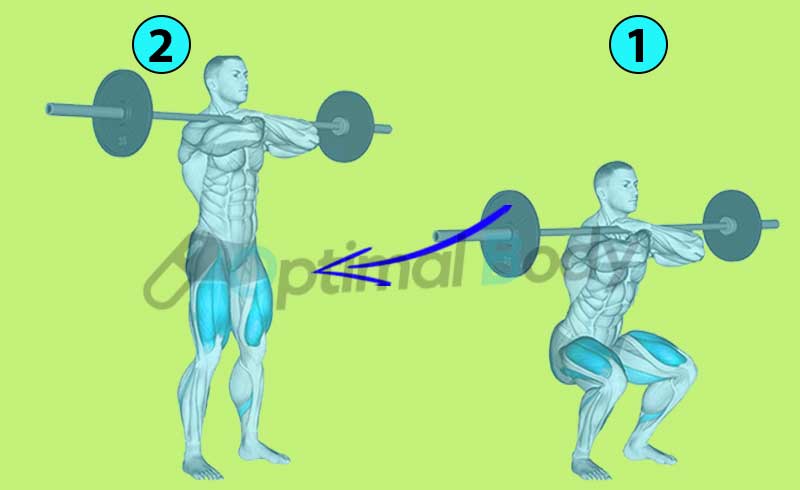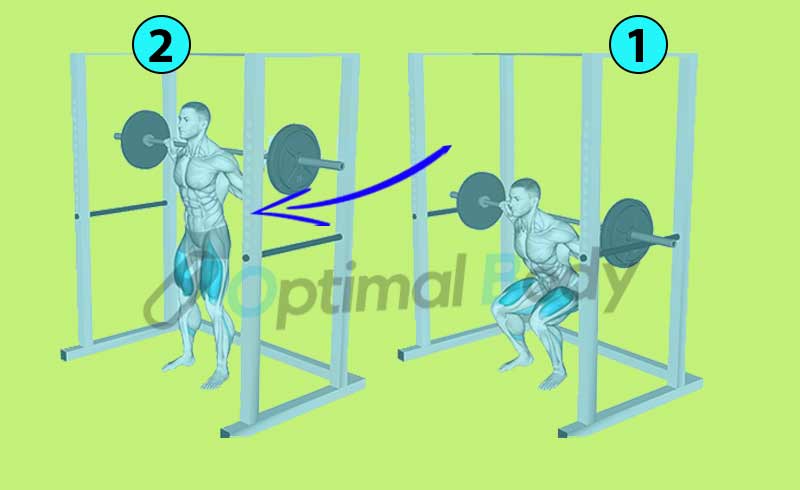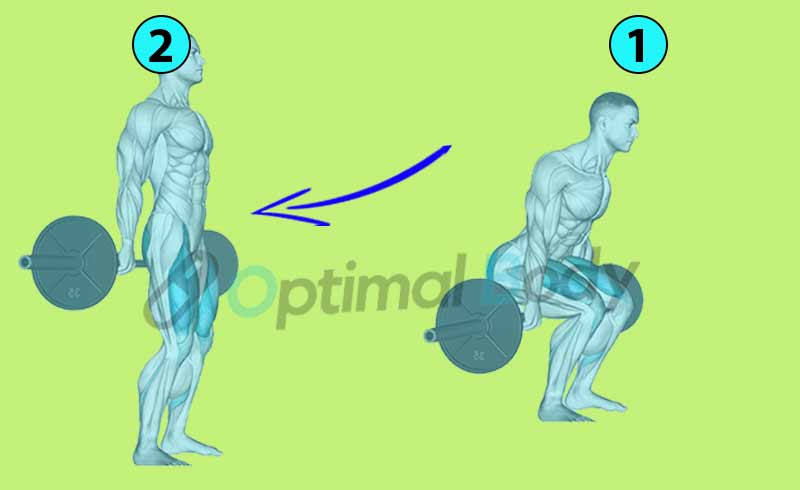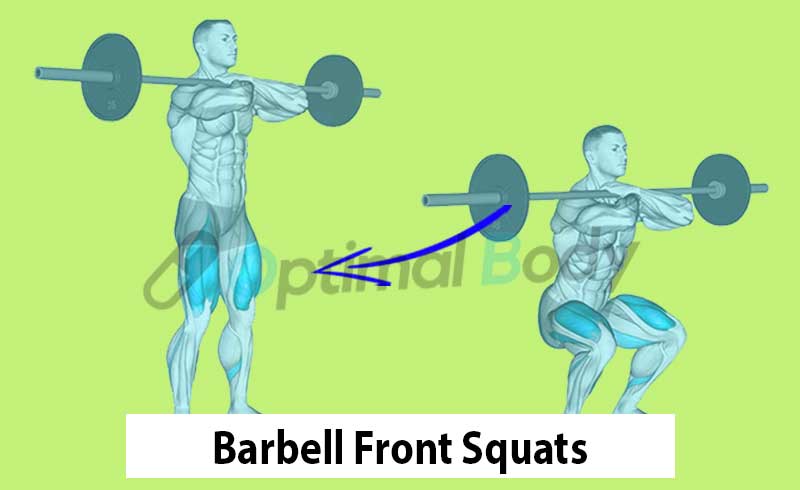When it comes to training your lower body and improving your overall strength, the barbell front squat is the best exercise that you simply can’t overlook.
This compound exercise works wonders on multiple muscle groups and delivers impressive results in just one movement.
In this article, we’ll dive deep into the world of barbell front squats, covering everything from muscles worked to variations and common mistakes.
Muscles Worked in the Barbell Front Squat
The barbell front squat is a leg exercise that targets several major muscle groups, primarily in the lower body:
- Quadriceps: The front squat places significant emphasis on your quads, making them a primary mover in this exercise. Research even suggests that they may be more activated compared to back squats, thanks to the upright torso position.
- Glutes: Your glutes play a crucial role in powering the lower part of the front squat, helping you achieve a strong and stable lift.
- Spinal Erectors: To maintain an upright and straight back during the front squat, your spinal erectors kick into action, ensuring proper form and preventing injury.
- Core: The front-loading nature of this exercise requires your core to engage for stability, resulting in an effective core workout.
- Shoulders: Holding the bar in the front rack position activates your deltoid muscles, which work hard to keep the barbell high and steady.
The Front Squat Benefits
Front squats offer a plethora of benefits that make them a valuable addition to your fitness regimen:
1. Leg Hypertrophy:
If you’re aiming for larger, more defined leg muscles, front squats are your ticket to success. Progressive overload, achieved by increasing weight, reps, or sets, can lead to substantial muscle growth.
2. Great for Beginners:
Front Barbell squats are an excellent choice for beginners, as they allow for a deeper squat and help maintain an upright torso. This makes it easier to maintain proper technique, even when fatigue sets in.
3. Increased Testosterone:
Engaging multiple muscle groups during front squats leads to higher intensity and, subsequently, greater testosterone production. This hormonal boost promotes muscle protein synthesis, aiding in muscle building.
4. Improved Posture:
Front squats foster thoracic extension, a game-changer for posture improvement. Maintaining an upright torso during the exercise carries over to better posture in your daily life, potentially reducing chronic pain symptoms.
How to Do Barbell Front Squats Correctly
Mastering the front squat with a barbell is essential to maximize its benefits and prevent injury.
Here’s a step-by-step instructions:

- Set the barbell in the squat rack at shoulder height, ensuring it’s under your chin and by the clavicle.
- Grip the bar with your thumbs on the outside of your shoulders.
- Pull your elbows out and forward, positioning them under the bar.
- Straighten your legs to unrack the bar, taking small steps back.
- Engage your core and maintain a proud chest with your elbows in line with your shoulders.
- Keep the barbell over your midfoot and descend into a squat, ensuring your thighs reach parallel or lower.
- Drive explosively through the floor to return to a standing position.
Front Squat Mistakes to Avoid
To get the most out of your front squats, steer clear of these common mistakes:
- Bar Pulling You Forward: Focus on keeping your chest open and core locked to prevent the bar from pulling you forward.
- Elbows Dropping: Keep your elbows high and avoid letting them drop towards your waist.
- Knees Caving In: Ensure your knees stay in line with your feet by pushing onto the outside of your trainers.
How to Use Straps for Squat Grip
If you find that your wrist mobility is limiting your lifting abilities, consider using lifting straps to assist you.
Here’s a step-by-step guide on how to use them effectively:
- Begin by wrapping the lifting straps around the bar, ensuring that they are secured at shoulder-width apart.
- Next, pull your elbows forward, positioning them beneath the bar, and firmly grip onto the straps.
- With your grip secured on the lifting straps, straighten your legs to unrack the bar. Take small steps backward to prepare yourself for your squatting routine.
By following these simple steps, you can make the most of lifting straps to overcome wrist mobility challenges and continue with your strength training safely and effectively.
Front Squats Variations using a Barbell
1. Pin Squats: Best for Quadriceps
The pin squat is an advanced barbell exercise tailored to maximize quadriceps activation. Popular among experienced fitness enthusiasts and athletes, this closed kinetic chain movement offers a unique challenge.
It is Ideal for individuals with mobility or flexibility limitations, providing a safe squatting option while working on a range of motion.
It starts from a lower position than traditional squats, effectively engaging the entire leg region, with a strong focus on the quadriceps.
To perform pin squats:

- Load a barbell on the squat rack, but place it lower than usual, positioning it for a half-squat start.
- Approach the barbell, secure it behind your shoulders, ensuring your legs are bent at around 90 degrees or slightly less.
- Carefully unrack the barbell, maintaining balance and form.
- Start the squat by pushing your hips back and bending your knees. Lower yourself until your thighs are parallel to the ground or slightly below, maintaining form.
- Rise back up to the starting position by pushing through your heels, fully extending your hips and knees.
- Complete your desired reps, emphasizing control and stability.
2. Hack Squat
Hack squats mimic the barbell front squat experience and target various leg muscles. They can be done with a machine or a loaded barbell behind the ankles.
How to do:

- Load a barbell with weights and place it on the floor behind your ankles.
- Stand with feet shoulder-width apart, toes slightly turned outward.
- Bend at hips and knees to grip the barbell, keeping your chest up.
- Thrust hips forward, pulling the barbell toward the back of your knees.
- Stand upright by extending hips and knees.
- Lower the barbell to the ground for one repetition.
Top Barbell Front Squat Alternatives
Let’s dive deeper into each front squat variation, providing detailed instructions on how to perform them and offering some valuable tips to enhance your technique and maximize your workout gains:
1. Dumbbell Goblet Squats
How to Perform:
- Hold a dumbbell vertically close to your chest with both hands, close to your body.
- Stand with your feet shoulder-width apart.
- Ensure your elbows are pointed down and inside your knees at the start.
- Keep your chest up and your core engaged.
- Lower yourself into a squat by bending at your hips and knees.
- Go as deep as you can while maintaining proper form, ideally with your hip crease going below your knee level.
- Push through your heels to return to a standing position, keeping your chest and head up throughout.
Tips:
- Choose an appropriate kb weight to challenge yourself without sacrificing form.
- Maintain a tight grip on the kb and keep your elbows in to avoid dropping it.
- Focus on controlled movements for maximum muscle engagement.
2. Double Kettlebell Front Squat
How to Perform:
- Clean a pair of kettlebells to the front of your shoulders, with your knuckles almost touching your chin.
- Stand with your feet shoulder-width apart.
- Keep your elbows high and in line with your shoulders.
- Engage your core and maintain an upright posture.
- Lower your body into a squat by bending at your hips and knees.
- Aim to get your hip crease below your knee level while keeping proper form.
- Drive through your heels to return to the starting position.
Tips:
- Make sure you have proper mobility and strength to clean the dumbbells to your shoulders.
- Keep your core engaged to maintain stability throughout the movement.
- Control the descent and ascent to maximize muscle engagement.
3. Barbell Back Squat
Barbell squats are a fundamental compound leg exercise where the barbell rests behind the neck on the shoulders. This alternative allows for heavier weights and is excellent for overall lower body strength.
How to Perform:
- Set up a barbell on a squat rack at chest height.
- Position the barbell on your upper back and shoulders.
- Hold the bar with a slightly wider than shoulder-width grip, elbows down.
- Step back, feet shoulder-width apart or slightly wider, toes turned out.
- Keep a strong core, engage glutes, and maintain an upright chest.
- Bend at hips and knees, ensuring knees align with toes.
- Lower until thighs are parallel or lower.
- Push through heels to stand up, fully extending hips and knees.
Barbell Squats Tips:
- Maintain a stable grip on the bar with elbows pointed down and back.
- Position your feet shoulder-width apart or slightly wider with toes slightly turned out for balance.
- Descend until your thighs are parallel to the ground or lower while maintaining proper form.
FAQs
Barbell Front Squat vs. Back Squat
Barbell front squats and back squats are both effective for lower body strength, yet they differ in key ways.
Front squats prioritize the quadriceps and demand better posture, benefiting the core and upper back.
Back squats, on the other hand, engage the hamstrings and glutes more. Your choice hinges on your objectives and body type. Front squats tend to be gentler on the back and are excellent for beginners.
Are Barbell Front Squats Good?
Indeed, barbell front squats excel in enhancing leg strength and posture. They target the quadriceps, glutes, and core, offering a holistic workout.
Front squats often prove safer for the back than their rear counterpart. They accommodate individuals across different fitness levels, from novices to advanced enthusiasts.
What Does Front Bar Squat Work?
Front bar squats primarily activate the quadriceps, situated at the front of your thighs. These squats also enlist the glutes, core, and upper back muscles to maintain form integrity.
The necessity of sustaining an upright torso promotes improved posture.
Why Is Front Squat Better?
Front squats gain favor among some due to their reduced lower back strain compared to back squats.
Their emphasis on maintaining an upright torso fosters better posture. They are a safer option for individuals with back concerns.
Nonetheless, the choice between front and back squats hinges on personal preferences and fitness objectives.
Conclusion:
Incorporating barbell front squat into your routine offers a multitude of benefits, from strengthening key muscle groups to improving posture.
By following proper form and avoiding common mistakes, you can maximize the advantages of this exercise.
Consider exploring variations like pin squats and hack squats to diversify your leg workouts and challenge your muscles further.
References
- Schoenfeld BJ, Grgic J, Ogborn D, Krieger JW. Strength and Hypertrophy Adaptations Between Low- vs. High-Load Resistance Training: A Systematic Review and Meta-analysis. J Strength Cond Res. 2017 Dec;31(12):3508-3523. doi: 10.1519/JSC.0000000000002200. PMID: 28834797.
- Stuart, Michael J. et al. “Comparison of Intersegmental Tibiofemoral Joint Forces and Muscle Activity During Various Closed Kinetic Chain Exercises.” The American Journal of Sports Medicine 24 (1996): 792 – 799.
- Graham, John MS, CSCS, *D. Front Squat. Strength and Conditioning Journal 24(3):p 75-76, June 2002.
- Gullett, Jonathan C. et al. “A Biomechanical Comparison of Back and Front Squats in Healthy Trained Individuals.” Journal of Strength and Conditioning Research 23 (2009): 284-292.
- Bench Press Calculator - April 22, 2024
- Press to Handstand: Ultimate Step-by-Step Guide - April 22, 2024
- Cable Press (How To Do, Benefits, Targeted Muscles, Alternative) - April 22, 2024

